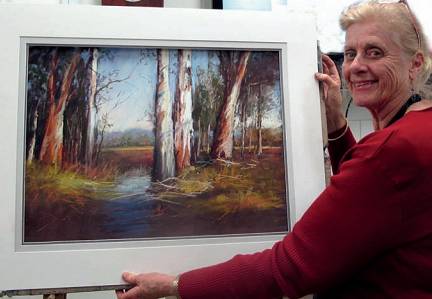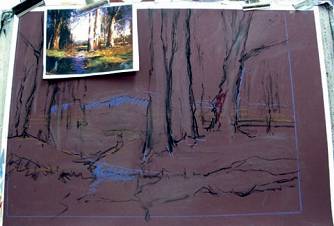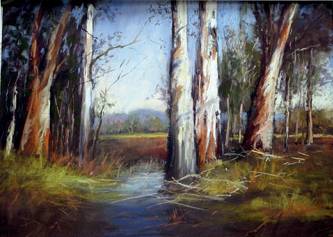Lorraine Wigraft Demonstration 19th July 2014
Pastel Landscape
 Lorraine
is a renowned, award-winning Pastel Artist; a member of the Pastel Society
of Victoria Australia (PSVA), tutor for 20 years at Whitehorse Arts
Association in Pastel, Oil and Acrylic and also a tutor at for many years
at Manningham Art Studios. Her work has been featured in the Australian
Artist magazine and the International Artist magazine.
Lorraine
is a renowned, award-winning Pastel Artist; a member of the Pastel Society
of Victoria Australia (PSVA), tutor for 20 years at Whitehorse Arts
Association in Pastel, Oil and Acrylic and also a tutor at for many years
at Manningham Art Studios. Her work has been featured in the Australian
Artist magazine and the International Artist magazine.
Lorraine and
the completed landscape
For this demonstration, Lorraine re-visited a scene she
had originally painted plein air at Millgrove in the Upper Yarra Valley.
Lorraine amused us with her description of the paint out. It was an
extremely hot day, about 40⁰C, so they all jumped in the river to cool off
when they had finished painting. (Note to members – pack your bathers when
you go to a paint out in Summer.)
 Lorraine’s
initial sketch & reference photo
Lorraine’s
initial sketch & reference photo
The sky was the first part of the painting with loose stokes on the side
of the pastel of bright blue merging to a grey-blue closer to the horizon.
She jumps all over the place to start with, preferring not to stay in one
part of the painting; however she usually works on getting the sky done
first. Next she tackled the distant hills and trees on the horizon. The
line between the sky and the distant hills was smudged to create the
impression of distance. There are a lot of different colours in the
background trees. Asked about the smudging which is frowned on by some
pastellists, Lorraine used it to blend the tones. As she said there are a
lot of rules in painting, but we are there to break them. She described
watching a video of Daniel Greene painting in pastel. He had a whole table
full of pastels, sorted by colour and tone. With that variety of tones you
don't need to smudge.
Unlike Oil and Acrylic, the colours are mixed on the paper in pastel
painting. She advises not doing straight lines with the pastel, but use it
like brush strokes, mixing the paint as you go. She also uses compressed
charcoal which she mixes with the greens to tone them down. Also she uses
Flinders Red for dark areas in the foreground and Flinders Blue for the
dark amongst the trees. It is important to put dark against light.
Lorraine passed on a lot of her techniques while working away at this
painting. She is very generous with the knowledge she has gained over
decades of painting.
One such technique is for keeping the pastels clean. During the painting,
have a rag handy to wipe the pastels as you go. She then demonstrated her
method of cleaning up at the end of the painting. Have two ice cream
containers, plain flour and an old sieve. Put flour and the pastels in one
ice cream container and then keep tipping from one container to the other.
When they look clean, sieve them and replace in your box.
When painting tree trunks, don't paint straight up and down, use slanted
strokes and make sure they look round. Start with light strokes at the
beginning.
Conte is useful for fine detail and takes a lot better than pastel
pencils. Any support can be used: a board painted with gesso; an acrylic
underpainting; pastel pencil can be used for the signature - red or lemony
white are good colours.
 How
do you know when it is finished? Lorraine's advice is to place it
somewhere that you can see it and then come back to it if you find
something needs fixing. Also a non-painter can sometimes point out things
we artists miss. Another suggestion is to turn the painting upside down or
on its side and you will see the problems straightaway.
How
do you know when it is finished? Lorraine's advice is to place it
somewhere that you can see it and then come back to it if you find
something needs fixing. Also a non-painter can sometimes point out things
we artists miss. Another suggestion is to turn the painting upside down or
on its side and you will see the problems straightaway.
A fantastic demonstration - a beautiful result and lots of useful
information. Thanks Lorraine.
The finished painting
Helen Halliday, WAA Newsletter Editor